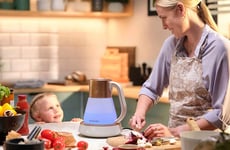
This Compact Robot Uses a Single Motor to Power Both Its Legs
Rahul Kalvapalle — December 28, 2023 — Tech
References: engineering.cmu.edu & interestingengineering
The 'Mugatu' is a bipedal robot that is designed to be able to use a single motor in order to move both of its legs, allowing for it to be significantly more diminutive and compact than typical bipedal robots.
This particular bipedal robot makes use of a singular lithium-polymer battery, while control is exercised by way of an included Arduino microcomputer. The robot measures in at only 18.5 cm tall, although the included technology is more than capable of being harnessed for robots that are far shorter. This is possible because the robot's center of gravity moves toward the first leg that moves forward, creating space for the other leg to move forward, creating a stable forward walking motion.
Ultimately, the advent of this robot goes to show that the advantages of walking bipedal robots can well and truly be leveraged in far smaller packages, allowing for applications such as industrial inspections and disaster relief searches.
Image Credit: Carnegie Mellon University
This particular bipedal robot makes use of a singular lithium-polymer battery, while control is exercised by way of an included Arduino microcomputer. The robot measures in at only 18.5 cm tall, although the included technology is more than capable of being harnessed for robots that are far shorter. This is possible because the robot's center of gravity moves toward the first leg that moves forward, creating space for the other leg to move forward, creating a stable forward walking motion.
Ultimately, the advent of this robot goes to show that the advantages of walking bipedal robots can well and truly be leveraged in far smaller packages, allowing for applications such as industrial inspections and disaster relief searches.
Image Credit: Carnegie Mellon University
Trend Themes
1. Compact Bipedal Robots - The 'Mugatu' showcases the potential of smaller bipedal robots with a single motor powering both legs.
2. Moving Towards Miniature - Advancements in bipedal robot technology enable the development of significantly shorter robots, like the 18.5 cm tall 'Mugatu.'
3. Expanding Applications for Bipedal Robots - The compact design of the 'Mugatu' opens up opportunities for industrial inspections and disaster relief searches utilizing bipedal robotics.
Industry Implications
1. Robotics - The 'Mugatu' demonstrates potential disruption in the robotics industry with its smaller form and efficient use of a single motor for both legs.
2. Industrial Inspections - Compact bipedal robots like the 'Mugatu' could revolutionize the field of industrial inspections, offering improved mobility and accessibility in confined spaces.
3. Disaster Relief - The 'Mugatu' presents an opportunity for bipedal robots to play a crucial role in disaster relief efforts by navigating challenging terrains and aiding in search and rescue missions.
1.9
Score
Popularity
Activity
Freshness
























